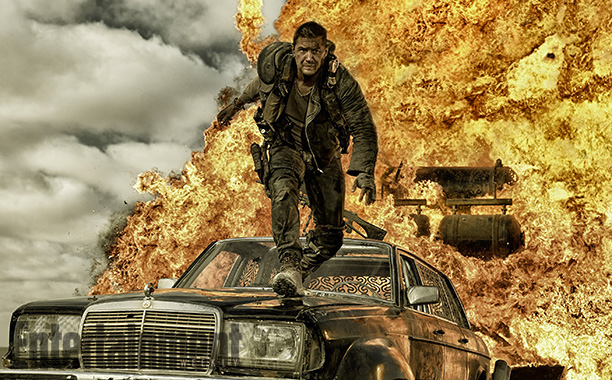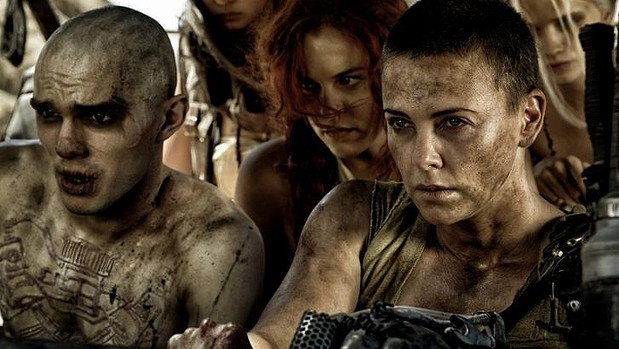Mad world.
Very few filmmakers could commit to the variety of ideas and characters that are on display in Mad Max: Fury Road without making a bad movie. There’s just such a bewildering anarchy to it all; no rational connections, just a storm of brutal awe that most imaginations couldn’t fathom let alone conceive. George Miller, returning to the saga that propelled him into prominence over thirty years ago, isn’t a perfect filmmaker but he’s certainly a unique one. There may never be another film like Mad Max: Fury Road, except of course the other Mad Max films. It’s a testament to Miller’s clarity of vision that his new film succeeds not only in existing amicably alongside the other entries in the franchise, particularly the second and the third, but that it also seems entirely current. That second consideration is particularly pertinent when you recognise how of their time the old Max films seem. Or seemed, because now Miller has somehow been completely uncompromising regarding the vision he started back in 1979 while avoiding aesthetic obsolescence. In fact, the only thing that seems different about Mad Max: Fury Road, is Max.
This isn’t a bad thing, particularly for franchise lovers. Tom Hardy fills the role that made Mel Gibson a superstar. He’s a very different Max, void of Gibson’s charm and effortlessness and sporting a distractingly ambiguous accent, but marvellous in all other regards. The switch in actor lends Fury Road the same timeless quality that lets the Broccoli’s get away with switching Bonds every decade or so without an uproar. Everyone has their favourite Bond, but none is without his merits. It doesn’t matter whether Hardy is as good as Gibson because better is neither here nor there. He’s different. Hardy’s physicality is exceedingly watchable and his presence immeasurable. Crucially, Max isn’t the strongest or the toughest. He just tries the hardest. Max shouldn’t have a dependable personality, because he’s anyone. He’s the lone gunman in Leone or the ronin samurai in Kurosawa, searching his land for meaning and finding very little.
It’s either surprising or astute or both that Max ends up being a supporting character in his own film, arguably an understated way of accepting Hardy to the role in the very least of understated films. Driving the narrative forward is Charlize Theron, who is nothing short of astounding as Imperator Furiosa. Furiosa is a lieutenant of the grotesque warlord Immortan Joe (Hugh Keays-Byrne). Keays-Byrne played Toecutter, the antagonist in the very first Mad Max, and it’s not a stretch to imagine that Joe is the post-apocalyptic extension of that character. Joe is the leader of the War Boys, a local troupe of mutated zealots who worship him as some form of God. Furiosa betrays Joe and sets off on one of, if not the finest, car chases committed to celluloid. Max is along for the ride.
The less you ponder the plot, the better, though Miller does an admirable job at conveying both narrative and character development amid the carnage. In fact, it’s the few times that Fury Road settles in which Miller’s discomfort for anything other than spectacle and broad strokes becomes evident. But it would be ruthless to bemoan Miller’s failings too extensively when his talents are so singular within the film industry. In an age of computer imagery that hasn’t been particularly astounding since Steven Spielberg wholeheartedly embraced the technique in Jurassic Park, Miller has crafted his feature-length chase almost entirely around practical effects. It’s been a regrettably long time since an audience feared for an actor’s life or a stunt person’s life. The entire film is a chase in a very literal sense and there’s the distinct impression that nothing that passed through Miller’s imagination was waylaid as a result of logistics. It’s no hyperbole to suggest that the action scenes in Fury Road are some of the most breathtaking in cinema history. The failings of CGI as an assumed tool rather than support isn’t a new one, but it’s true.
Fury Road doesn’t acknowledge the chronology of the other films. Fury Road doesn’t care about the chronology of the other films. Miller is madder than Max (an extension of the filmmaker in the first place). It’s comforting, for no tangible reason, that a seventy-year-old filmmaker can return to the world in which he begun and create something as unique, entertaining and energetic as any of the three original Mad Max films. These films aren’t meant to be scrutinised or analysed. There’s no logic or consideration or motivation, It’s a world of metal, blood, rage and gasoline and that’s just about all there is too it. It’s spectacle of the most admirable kind. Miller was reportedly influenced by Hitchock’s notion regarding making a film that can be appreciated anywhere in the world without subtitles. He’s succeeded.
9/10
For more Reviews, click here. If you’re digging ReelGood, sign up to our mailing list for exclusive content, early reviews and chances to win big!

